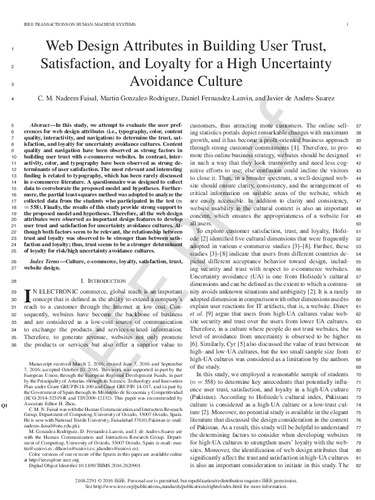Web Design Attributes in Building User Trust, Satisfaction, and Loyalty for a High Uncertainty Avoidance Culture
Subject:
Human computer interaction
Culture
E-commerce
Loyalty
Publication date:
Editorial:
IEEE
Publisher version:
Citación:
Descripción física:
Abstract:
In this study, we attempt to evaluate the user pref6 erences for web design attributes (i.e., typography, color, content 7 quality, interactivity, and navigation) to determine the trust, sat8 isfaction, and loyalty for uncertainty avoidance cultures. Content 9 quality and navigation have been observed as strong factors in 10 building user trust with e-commerce websites. In contrast, inter11 activity, color, and typography have been observed as strong de12 terminants of user satisfaction. The most relevant and interesting 13 finding is related to typography, which has been rarely discussed 14 in e-commerce literature. A questionnaire was designed to collect 15 data to corroborate the proposed model and hypotheses. Further16 more, the partial least-squares method was adopted to analyze the 17 collected data from the students who participated in the test (n 18 = 558). Finally, the results of this study provide strong support to 19 the proposed model and hypotheses. Therefore, all the web design 20 attributes were observed as important design features to develop 21 user trust and satisfaction for uncertainty avoidance cultures. Al22 though both factors seem to be relevant, the relationship between 23 trust and loyalty was observed to be stronger than between satis24 faction and loyalty; thus, trust seems to be a stronger determinant 25 of loyalty for risk/high uncertainty avoidance cultures
In this study, we attempt to evaluate the user pref6 erences for web design attributes (i.e., typography, color, content 7 quality, interactivity, and navigation) to determine the trust, sat8 isfaction, and loyalty for uncertainty avoidance cultures. Content 9 quality and navigation have been observed as strong factors in 10 building user trust with e-commerce websites. In contrast, inter11 activity, color, and typography have been observed as strong de12 terminants of user satisfaction. The most relevant and interesting 13 finding is related to typography, which has been rarely discussed 14 in e-commerce literature. A questionnaire was designed to collect 15 data to corroborate the proposed model and hypotheses. Further16 more, the partial least-squares method was adopted to analyze the 17 collected data from the students who participated in the test (n 18 = 558). Finally, the results of this study provide strong support to 19 the proposed model and hypotheses. Therefore, all the web design 20 attributes were observed as important design features to develop 21 user trust and satisfaction for uncertainty avoidance cultures. Al22 though both factors seem to be relevant, the relationship between 23 trust and loyalty was observed to be stronger than between satis24 faction and loyalty; thus, trust seems to be a stronger determinant 25 of loyalty for risk/high uncertainty avoidance cultures
Patrocinado por:
The authors would like to thank D. Meana and J. Castro from the University of Oviedo for web development. This work has been funded by the European Union, through the European Regional Development Funds (ERDF); the Principality of Asturias, through its Science, Technology and Innovation Plan (grants GRUPIN14-100 and GRUPIN 14-017) and the Goverment of Spain through its Ministerio de Economa y Competitividad (ECO-2014-52519-R and TIN2009-12132)
Collections
- Artículos [37533]
- Informática [870]
- Investigaciones y Documentos OpenAIRE [8306]
Files in this item




